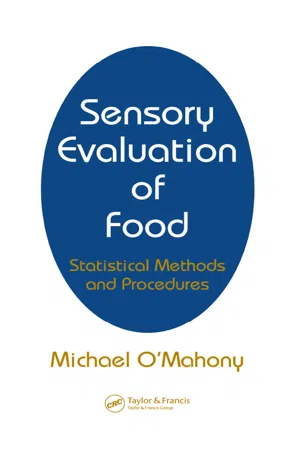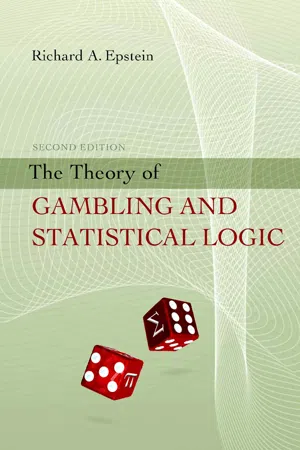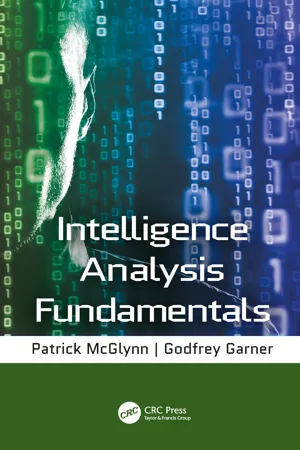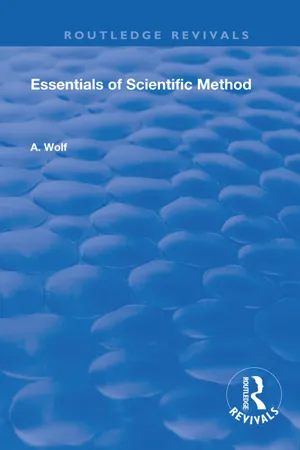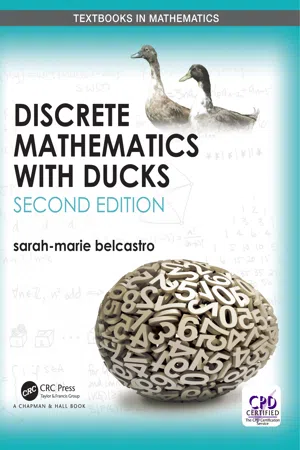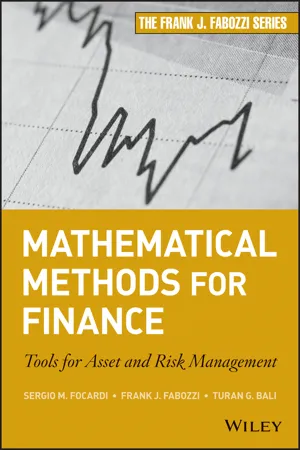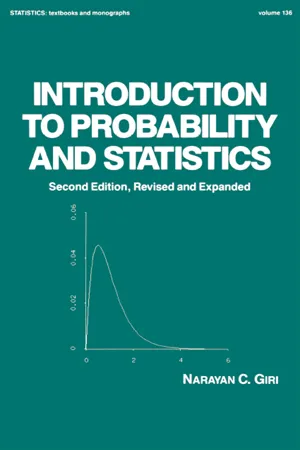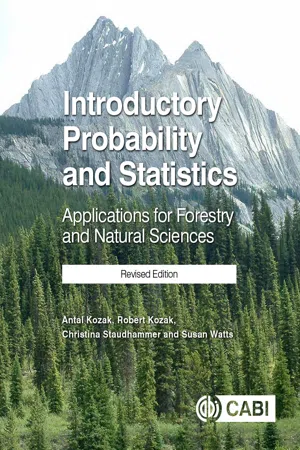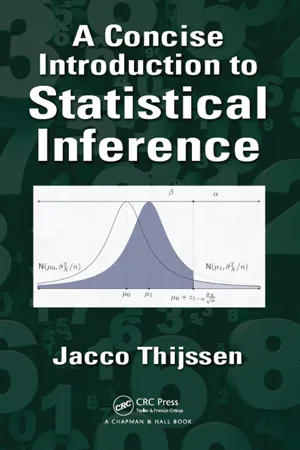Mathematics
Probability Calculations
Probability calculations involve determining the likelihood of a specific event occurring, often expressed as a number between 0 and 1. This is done by analyzing the possible outcomes and their associated probabilities. Key concepts include the use of formulas such as the probability of an event A given event B, and the addition and multiplication rules for combining probabilities.
Written by Perlego with AI-assistance
Related key terms
11 Key excerpts on "Probability Calculations"
- eBook - ePub
Sensory Evaluation of Food
Statistical Methods and Procedures
- Michael O'Mahony(Author)
- 2017(Publication Date)
- CRC Press(Publisher)
3 Probability, Sorting, and Arranging 3.1 What is Probability? Before dealing with the various statistical tests, it is worthwhile deviating for a while to examine the nature of probability and how to calculate various probability values. Basically, probability is a number used to express the likelihood of a given event happening. Instead of simply saying that something is likely or unlikely, we say that it has a 10% (or 50% or 90% or whatever) chance of happening. Probability is described by a number which can range between 0 and 1. 0 indicates the absolute impossibility of the event concerned; 1 indicates absolute certainty; 0.5 indicates that there is an equal chance of the event occurring or not occurring. Similarly, probability can be described in percentages (i.e., 0 to 100%). There are two approaches to the definition and calculation of the probability of an event: If we know all the possible outcomes of a set of events, we can calculate the probability of one or more of these outcomes occurring. This value is known as a priori probability or Laplacean or classical probability. It is commonly used in problems about games involving dice, cards, etc. (this reflects something of the social history of statistics.). For example, the probability of a tossed coin coming down “heads” is 1/2. The key point here, however, is that this kind of probability can be computed before the event takes place; it can be calculated a priori. The other approach rests on experience and is called a posteriori or empirical probability. Here the probability of an event happening is computed from experience rather than being predicted in advance. For instance, the probability of getting a “head” when tossing a coin is 1/2; it can be predicted in advance and is thus an a priori probability - eBook - ePub
- Richard A. Epstein(Author)
- 2009(Publication Date)
- Academic Press(Publisher)
Notwithstanding this diversity of thought regarding the philosophical foundations of the theory of probability, there has been almost universal agreement as to its mathematical superstructure. And it is mathematics rather than philosophy or semantic artifacts that we summon to support statistical logic and the theory of gambling. Specifically in relation to gambling phenomena, our interpretation of probability is designed to accommodate the realities of the situation as these realities reflect accumulated experience. For example, a die has certain properties that can be determined by measurement. These properties include mass, specific heat, electrical resistance, and the probability that the up-face will exhibit a “3.” Thus we view probability much as a physicist views mass or energy. Rational probability is concerned with the empirical relations existing among these types of physical quantities.The Calculus of Probability
Mathematics, qua mathematics, is empty of real meaning. It consists merely of a set of statements: “if …, then … .” As in Euclidean geometry, it is necessary only to establish a set of consistent axioms to qualify probability theory as a rigorous branch of pure mathematics. Treating probability theory, then, in a geometric sense, each possible outcome of an experiment is considered as the location of a point on a line. Each repetition of the experiment is the coordinate of the point in another dimension. Hence probability is a measure—like the geometric measure of volume. Problems in probability are accordingly treated as a geometric analysis of points in a multidimensional space. Kolmogorov has been largely responsible for providing this axiomatic basis.Axioms and Corollaries
A random event is an experiment whose outcome is not known a priori . We can stateAxiom I : To every random event A there corresponds a number P (A ), referred to as the probability of A , that satisfies the inequalityThus the measure of probability is a nonnegative real number in the range 0 to 1.Now consider an experiment whose outcome is certain or whose outcomes are indistinguishable (tossing a two-headed coin). To characterize such an experiment, let E - Amit Kumar Gorai, Snehamoy Chatterjee(Authors)
- 2022(Publication Date)
- CRC Press(Publisher)
2 Basics of probability and statistics DOI: 10.1201/9781003200703-2 2.1 Definition of probability Probability is defined as the chances of occurrence of any event in an experiment. The sum of all the possible outcomes is called the sample space, and a subset of sample space is known as an event. If there are S exhaustive (i.e., at least one of the events must occur), mutually exclusive (i.e., only one event occurs at a time), and equally likely outcomes of a random experiment (i.e., equal chances of occurrence of each event) and r of them are favourable to the occurrence of an event A, the probability of the occurrence of the event A is given by P (A) = r S (2.1) It is sometimes expressed as ‘odds in favour of A ’ or the ‘odds against A ’. The ‘odds in favour of A ’ is defined as the ratio of occurrence of event A to the non-occurrence of event A. On the other hand, ‘odds against A ’ is defined as the ratio of non-occurrence of event A to the occurrence of. event A Odds in favour of A = P r o b a b i l i t y o f o c c u r r e n c e o f e v e n t A P r o b a b i l i t y o f non-occurrence o f e v e n t A = r / S (S − r) / S = r S − r Again, Odds against A[--=PLGO-SEPARATOR. =--]= P r o b a b i l i t y o f non-occurrence o f e v e n t A P r o b a b i l i t y o f o c c u r r e n c e o f e v e n t A = (S − r) / S r / S = S − r r The total probability of the occurrence of any event ranges from 0 to. 1. i.e., 0 ≤ P (A) ≤ 1 P (A) = 0 indicates event A is impossible, and P (A) = 1 indicates the event is certain. In the above discussion, the discrete sample space was considered. But, the probability can also be determined for a continuous sample space. For a continuous sample space, the probability of occurrence is measured as a probability density function. The probability density function of any continuous random variable gives the relative likelihood of any outcome in a specific range- eBook - ePub
- Godfrey Garner, Patrick McGlynn(Authors)
- 2018(Publication Date)
- CRC Press(Publisher)
This is the simplest manner of inference using one known, event “A,” and one dependent variable, event “B.” You can put it in terms of an “if/then” statement, such as, if “A” occurs, then “B” occurs with some estimation of likelihood. Simple inference, or probability, is the likelihood that a specific event will occur, represented by a number between 0 and 1. There are two categories of simple probabilities: Theoretical and experimental. Analysts use both.Theoretical Probability
Theoretical probability is calculated probability. If every event is equally likely, it is the ratio of the number of ways the event can occur to the total number of possible outcomes. It can be expressed mathematically asTheoretical probability=Number of ways to get want you want (or favorable outcomes) Total number of possible outcomesExperimental Probability
Experimental probability is the probability based on data collected from experimentation. It can be expressed mathematically asExperimental probability =Number of times the event occured Total number outcomesConditional Probability
The concept of conditional probability is one of the most basic and fundamental and at the same time one of the most important concepts in probability theory. That said, conditional probabilities can also be perfidious and require careful analysis and interpretation.Calculating Risk of Terrorist Attack
Experts on risk analysis have put forth the equation of Risk = Consequence × Vulnerability × Threat.10 Extending this train of thought and laying it out mathematically, Risk of Attack [P(A)] = Consequences [P(C)] × Vulnerability [P(V)] × Threat [P(T)].Historical Application
Using these variables (consequence, vulnerability, and threat), let us look back at the earlier Pearl Harbor example and see how the “risk” might have been perceived. The consequences of possibly losing the U.S. Navy’s Pacific fleet were significant, and the vulnerability factor was also severe. However, the “threat” was perceived to be very low, because naval analysts could not recognize that a significantly large sea-based air strike capability (several carriers and their support auxiliaries) would be able to cross thousands of miles of open sea without detection to achieve a successful attack. - J. P. Verma(Author)
- 2014(Publication Date)
- Wiley(Publisher)
Chapter 4 Probability and its Application4.1 Introduction
Probability is a chance of an event happening in the future. In our day-to-day decisions, we use the concept of probability. While driving the car we assume that the probability of accidents is very low, or we would not drive the car. During a cricket match, we often assume a low probability of being hit by another player. During a tennis match, a player needs to take a call on whether the ball will cross the sideline, and if he feels that it is highly probable that the ball would fall outside the line, he leaves it. If the player does not make that assumption, he would probably not leave the ball for fear of losing a point. In assuming many probabilities, we constantly live in fear of the horrible things that might happen to us. Decisions based on probability and statistics provide us with the ability to cope with uncertainty. It has tremendous power in improving the accuracy in our decision-making capacity and in testing new ideas. Within probability and statistics, there are many applications with profound or unexpected results. Let us see how the concept of probability came into existence.Probability theory grew out of attempts to understand gambling. Gambling was popular before the theory of probability was formed. Gamblers used to identify simple laws of probability by witnessing the events firsthand. The notion of probability has been around for thousands of years, but probability theory as a branch of mathematics did not come into existence until the mid-seventeenth century. Several works on probability were noticed during the fifteenth century. Computing probabilities became more noticeable during this period even though mathematicians in Italy and France remained unfamiliar with these calculation methods.During the mid-seventeenth century, a simple question posed to Blaise Pascal by his friend led to the birth of probability theory as we know it today. Chevalier de Méré used to gamble frequently to increase his wealth. He bet on the throw of a dice that at least one 6 would appear during a total of four throws. From his past experience, he knew that he was more successful than not with this game of chance. He was tired of this approach and wanted to do something different. He bet that he would get a total of 12 in throwing two dice 24 times.- eBook - ePub
- A. Wolf(Author)
- 2019(Publication Date)
- Routledge(Publisher)
r = 0, according to the nature of the case. In this fuller form we see the basis of the probability of the recurrence of partial correlations or associations, as ascertained by the statistical method of exact enumeration. What has just been said about the probability of inductions by simple enumeration applies here likewise.§ 7. The Use of Calculations of Probability.Lastly, of what practical value is the whole calculus of probability? Some people have very exaggerated notions of its practical value. This is partly due to our respect for figures, in consequence of the important place which mathematics holds in modern science. One tacitly assumes that exact figures express precise knowledge, and one has no suspicion of the ill-defined nebulosities that may masquerade in precise ratios and fractions. Partly, however, the exaggeration is also due to the frequency-theory of probability. This theory rather encourages the confusion of probabilities with frequencies. There is, of course, a connection between them. We have seen that probability can, in many cases, only be calculated on the basis of observed frequencies. Nevertheless, probability and frequency are not identical. Now frequencies, when treated with the necessary precautions, may be of the greatest practical value—as is evident from their use in insurance business and in kindred enterprises. But the calculus of probability is another matter. Probability is concerned even with single events and small groups or series of events, while frequencies always refer to large classes, or long series of events, to what happens “in the long run.” The practical difference is obvious, even in roulette. The bank, doing business with large numbers of players, can rely on frequencies which secure it certain advantages. The individual player, limited to a much smaller number of ventures, simply gambles, and usually pays dearly for his estimates of probability, even when these are based on rational calculations, and are not merely the result of inspiration or superstition. The calculus of probability is, of course, secure of its reputation, just like the ambiguous oracles of antiquity. Whatever happens, the calculus is right. Whether you win or lose, whether you have a long run of good luck, or of ill luck, the calculus is equally right. This may console those who cherish their delusions more than their treasure; but sensible people will not put their trust in such ambiguous oracles. There are, it is true, ingenious gambling systems, based on frequencies rather than on probabilities. But even these systems have their day and cease to be. The best of them is but a snare, cheating the fowler of a bird in the hand for two in the bush. Its validity always depends on “the long run,” which easily outruns the resources of any ordinary individual. For similar reasons, even in legitimate insurance business, the company, relying on frequencies, is on a much better footing than the individual client. But the practical exigencies of life often make it advisable for the individual to take high risks for small amounts rather than incur low risks for large amounts—not to mention the benefits which accrue to the community as a whole from insurance organizations. No precision of figures can eliminate the essential uncertainty of the probable. And, in the last resort, the best method of estimating the probability of anything is by a close examination of the actual conditions. Even insurance companies do not rely entirely on frequencies, but have each case examined by an expert (doctor, or engineer, etc.), according to the nature of the risk. This is done primarily in order to determine accurately to what precise class the risk belongs, since each class has its own frequency. But that is not the whole explanation. For, if everything were taken into account indiscriminately, each case would be sui generis - eBook - ePub
- sarah-marie belcastro(Author)
- 2018(Publication Date)
- Chapman and Hall/CRC(Publisher)
A second Try This! gives many fun conditional Probability Calculations; you’d better remember PIE to be able to complete them! We then return to expected value so that you can get a glimpse of the most common use of probability in discrete mathematics—the probabilistic method. To avoid potential confusion, our strategy will be to use a precise and detailed approach. A benefit of this comparatively elaborate introduction is to use language that is consistent with more advanced treatments of probability, so that when you encounter them (as surely you will!) you will recognize the terminology and ideas. 14.2 What Is Probability, Exactly? According to English dictionaries, a probability is the likelihood that some given event will occur. So in mathematics, the study of probability is the study of likelihoods of events. In order to focus on discrete probability (hey, this is discrete mathematics), we will only consider situations where there are a finite number of different events that might occur. Example 1.1 When flipping a fair coin, it is equally likely that it will land heads up and that it will land tails up. The probability of it landing heads up is 1 2, as is the probability of it landing tails up. When rolling a fair die, it is equally likely that it will land with any particular face pointing towards the viewer. If the die has six faces, then the probability of rolling a 2 is 1 6 (as is the probability of rolling a 1, 3, 4, 5, or 6). If the die has eight faces, then the probability of rolling a 2 is 1 8 (as is the probability of rolling a 1, 3, 4, 5, 6, 7, or 8). Definition 1.2 A state space is the set of different states or configurations that a system might have. It is also called a sample space. Example 1.3 [of state spaces] For an ordinary light switch, the state space is S L = { o n, o f f }. For a coin to be flipped, the state space is S C = { h e a d s, t a i l s } - eBook - ePub
Mathematical Methods for Finance
Tools for Asset and Risk Management
- Sergio M. Focardi, Frank J. Fabozzi, Turan G. Bali(Authors)
- 2013(Publication Date)
- Wiley(Publisher)
The axiomatic theory of probability avoids the above problems by interpreting probability as an abstract mathematical quantity. Developed primarily by the Russian mathematician Andrei Kolmogorov, the axiomatic theory of probability eliminated the logical ambiguities that had plagued probabilistic reasoning prior to his work. The application of the axiomatic theory is, however, a matter of interpretation.In financial economic theory, probability might have two different meanings: (1) as a descriptive concept and (2) as a determinant of the agent decision-making process. As a descriptive concept, probability is used in the sense of relative frequency, similar to its use in the physical sciences: The probability of an event is assumed to be approximately equal to the relative frequency of its occurrence in a large number of experiments. There is one difficulty with this interpretation, which is peculiar to economics: empirical data (i.e., financial and economic time series) have only one realization. Every estimate is made on a single time-evolving series. If stationarity (or a well-defined time process) is not assumed, performing statistical estimation is impossible.PROBABILITY IN A NUTSHELLIn making probability statements, we must distinguish between outcomes and events. Outcomes are the possible results of an experiment or an observation, such as the price of a security at a given moment. However, probability statements are not made on outcomes but on events , which are sets of possible outcomes. Consider, for example, the probability that the price of a security be in a given range, say from $10 to $12, in a given period.In a discrete probability model (i.e., a model based on a finite or at most a countable number of individual events), the distinction between outcomes and events is not essential as the probability of an event is the sum of the probabilities of its outcomes. If, as happens in practice, prices can vary by only one-hundredth of a dollar, there are only a countable number of possible prices and the probability of each event will be the sum of the individual probabilities of each admissible price.However, the distinction between outcomes and events is essential when dealing with continuous probability models. In a continuous probability model, the probability of each individual outcome is zero though the probability of an event might be a finite number. For example, if we represent prices as continuous functions, the probability that a price assumes any particular real number is strictly zero, though the probability that prices fall in a given interval might be other than zero. - eBook - ePub
- Giri(Author)
- 2019(Publication Date)
- CRC Press(Publisher)
Section 2.1.1 we evaluated probabilities of events by the direct application of the definition of probability, and this involved direct enumeration of the total number of equally likely cases and the number of cases favorable to an event. As problems grow in complexity the difficulty of direct enumeration of these cases also grows, and the computation of probabilities by direct application of the definition gets more involved. We shall now develop some theorems in probability with a view to avoiding these complications.A theorem in probability aims at deducing an algebraic relationship between probabilities of various related events, such that given the probabilities of some of these events, the probabilities of some other events that can be explained by them in some manner can be evaluated. That this is possible can be seen from the following simple example: If the probability that an event A will happen is p, the probability that the event A will not happen, usually represented as the eventA ¯, is 1 − p, whatever the event A may be. When the probability of A is given, the probability ofA ¯can be deduced immediately.Our general aim will be to develop a calculus of probability based on theorems on probability. The general logical scheme of the calculus of probability is as follows: Given the probabilities of a set S of events for a set of random experiment E 1 , E 2 ,…, and given another random experiment E *, which is related to E 1 , E 2 ,… in a known manner, we should be able to make statements about the probabilities of specified events for E *, which can be explained in terms of the set S of events for E 1 , E 2 ,… in a certain sense.Two theorems are of fundamental importance in developing a calculus of probability: the theorem of total probability and the theorem of compound probability. The statements of these theorems involve some basic concepts, such as mutually exclusive events, compound events, conditional probability of an event given another event, and mutually independent events. Of these, we have already defined mutually exclusive events. The definitions of the remaining concepts appear below.Throughout we denote an event A by the symbol (A) and express the probability of (A) as P(A). Consider an event A in conjunction with another event B - eBook - ePub
Introductory Probability and Statistics
Applications for Forestry and Natural Sciences (Revised Edition)
- Robert Kozak, Antal Kozak, Christina Staudhammer, Susan Watts(Authors)
- 2019(Publication Date)
- CAB International(Publisher)
3 Probability The Foundation of Statistics We use statistical information every day to qualify statements and to help us make decisions. For example, we may hear statements like: • There is an 80% chance of rain today. • The odds are one in 13 million that you will win the lottery. Or we may be confronted with questions like: • What is the likelihood of receiving an A on the first exam in this course? • What is the chance that the Vancouver Canucks will win the next Stanley Cup? Statistical inference, the generalization from a sample to a population, involves drawing a conclusion about a population on the basis of available, but incomplete, information. Hence, statistical inference involves a certain amount of uncertainty, and statisticians should not base decisions on statistical inference unless the risk of uncertainty can be reduced to a tolerable minimum. Problems involving ‘uncertainty’, ‘chance’, ‘likelihood’, ‘odds’ and other such factors require an understanding and application of the theory of probability. Probability is the branch of mathematics that incorporates the most important set of concepts used in the field of statistics. The purpose of this chapter is to introduce the basic theories of probability that are required to appreciate and understand many of the concepts of statistical inference. 3.1 Sample Space and Events In statistics, we define an experiment as a process that produces some data. In Chapter 1, we described an experiment to study the effects of seeding date and seedbed preparation on germination. A wood scientist could be interested in studying the effect of temperature and applied pressure on the strength properties of plywood. Experi ments such as tossing a coin, rolling a dice, or drawing a card from an ordinary (52 cards) deck of cards will also produce some data - eBook - ePub
- Jacco Thijssen(Author)
- 2016(Publication Date)
- Chapman and Hall/CRC(Publisher)
Chapter 2Theory and Calculus of Probability
The theory of statistical inference is based on probability theory, the starting point of which is a probability model. This is a mathematical description of some experiment that is subject to randomness, such as flipping a coin, rolling a die, asking a voter which party (s)he will vote for, testing a new wing design for aircraft in a wind tunnel to measure drag, etc. This chapter introduces the parts of probability theory that are useful for (basic) statistical inference.2.1 Probability models
When thinking about how to write down an abstract model of experiments that involve random outcomes, it helps to keep a simple example in mind. An easy one is rolling a (six-sided) die. There are three fundamental ingredients in describing this experiment. First, we need to be able to write down every outcome that can occur (here: {1, 2, 3, 4, 5, 6}). Secondly, we must be able to describe all the configurations of outcomes (which we will call “events”) to which we want to assign a probability. For example, the event “an even number comes up” is described by {2, 4, 6}. Finally, we need to assign probabilities to events. For example, if the die is fair, you would assign the probability 1/2 to the event that an even number comes up.Abstracting from this particular example, a probability model is a triple (Ω, ℱ, P), where Ω is the set of all possible outcomes, and ℱ is the set of all possible events. The set of events should satisfy some properties that ensure that we can assign probabilities to all events we might conceivably want to assign them to.(E1) The set of outcomes is an event. In mathematical notation:1 Ω ∈ ℱ.(E2) If A is an event, then so is “not A.” In mathematical notation: A ∈ ℱ ⇒ Ac ∈ ℱ.(E3) If you take any (countable2 ) collection of mutually exclusive events, then their union is also an event. In mathematical notation:A 1,A 2, ⋯ ∈ F ⇒∪k = 1∞A k∈ F
Index pages curate the most relevant extracts from our library of academic textbooks. They’ve been created using an in-house natural language model (NLM), each adding context and meaning to key research topics.
